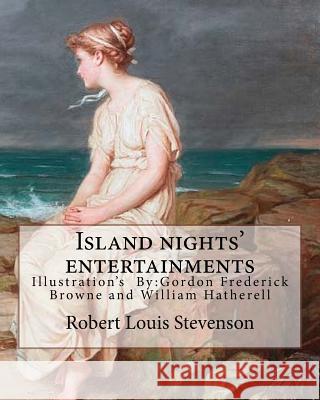Island nights' entertainments By: Robert Louis Stevenson, illustrated By: Gordon Browne and By: W.(William) Hatherell: Gordon Frederick Browne (15 Apr » książka
Island nights' entertainments By: Robert Louis Stevenson, illustrated By: Gordon Browne and By: W.(William) Hatherell: Gordon Frederick Browne (15 Apr
ISBN-13: 9781548964078 / Angielski / Miękka / 2017 / 94 str.
Island nights' entertainments By: Robert Louis Stevenson, illustrated By: Gordon Browne and By: W.(William) Hatherell: Gordon Frederick Browne (15 Apr
ISBN-13: 9781548964078 / Angielski / Miękka / 2017 / 94 str.
(netto: 34,20 VAT: 5%)
Najniższa cena z 30 dni: 35,72
ok. 16-18 dni roboczych
Bez gwarancji dostawy przed świętami
Darmowa dostawa!
Robert Louis Balfour Stevenson (13 November 1850 - 3 December 1894) was a Scottish novelist, poet, essayist, and travel writer. His most famous works are Treasure Island, Kidnapped, Strange Case of Dr Jekyll and Mr Hyde, and A Child's Garden of Verses. A literary celebrity during his lifetime, Stevenson now ranks as the 26th most translated author in the world. His works have been admired by many other writers, including Jorge Luis Borges, Bertolt Brecht, Marcel Proust, Arthur Conan Doyle, Henry James, Cesare Pavese, Emilio Salgari, Ernest Hemingway, Rudyard Kipling, Jack London, Vladimir Nabokov, J. M. Barrie, and G. K. Chesterton, who said of him that he "seemed to pick the right word up on the point of his pen, like a man playing spillikins..".......... Gordon Frederick Browne (15 April 1858 - 27 May 1932) was an English artist and children's book illustrator in the late 19th century and early 20th century. He was born in Banstead, the younger son of notable book illustrator Hablot Knight Browne (who as "Phiz" illustrated books by Charles Dickens). He studied art at the Heatherley School of Fine Art and South Kensington Schools and started to receive professional commissions while still at college. From the 1880s, Browne was one of Britain's most prolific illustrators, his work appearing in newspapers, magazines and many books by children's authors including Frederic William Farrar, G.A. Henty, Juliana Horatia Ewing, Andrew Lang, Talbot Baines Reed, L. T. Meade, Catherine Christian and E. Nesbit........ WILLIAM HATHERELL (1855-1928) William Hatherell was a Victorian era illustrator who worked for magazines such as The Graphic, Harpers, Scribner's and the Century. Today he is mostly remembered for crudely printed images such as these: he printing technology in Hatherell's day was pretty primitive. Combined with cheap paper stock, it stripped Hatherell's work of much of its sensitivity and expressiveness. Of course, like all resourceful artists Hatherell made the best of his limitations; he emphasized strong compositions and high contrasts that could survive the publication process.Hatherell might easily have used the disadvantages of his medium as an excuse for dashing off fast, limited work. Many artists did. In fact, his employers encouraged him to do so, in order to increase productivity and profits. Instead, Hatherell worked carefully and deliberately, crafting sensitive pictures with subtle features that were undetectable to his larger audience. As one contemporary noted, Hatherell stubbornly refused to lower his standards: Hatherell became noted for his refusal to be pressured into hasty work. For illustrating current events, for instance, he used models, often carefully posed in his backyard....
Zawartość książki może nie spełniać oczekiwań – reklamacje nie obejmują treści, która mogła nie być redakcyjnie ani merytorycznie opracowana.











